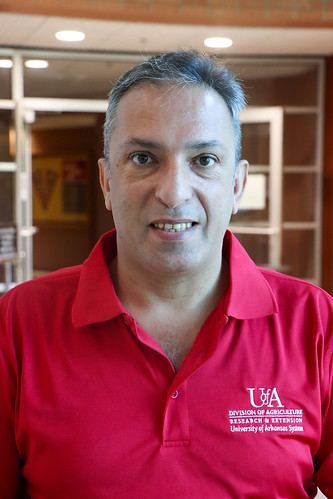Poultry science researcher awarded grant to help develop vaccine against costly disease
By Jessica Wesson
U of A System Division of Agriculture
April 14, 2023
Fast facts
- Researchers to research vaccine against bacterial chondronecrosis with osteomyelitis
- Disease causes lameness in chickens, results in millions of dollars in losses
- $80,000 grant from USPOULTRY Foundation to support the work
(553 words)
FAYETTEVILLE, Ark. — Researchers in Arkansas are beginning research to help develop a new broiler chicken vaccine targeting a disease that causes millions of dollars in losses each year.

“Broiler chicken lameness caused by bacterial chondronecrosis with osteomyelitis is one of the top economic and animal welfare issues facing the poultry industry today,” said Adnan Alrubaye, assistant professor of poultry science. “It causes losses of hundreds of millions of dollars annually in the United States and other broiler-producing countries because of bird condemnation at market age.”
The work will be supported by an approximately $80,000 grant from the USPOULTRY Foundation.
Alrubaye, who is also associate director of the graduate program in cell and molecular biology, conducts research for the University of Arkansas System Division of Agriculture through its research arm, the Arkansas Agricultural Experiment Station.
Alrubaye’s research aims to develop and test a vaccine that protects against five bacterial species that usually cause bacterial chondronecrosis with osteomyelitis. The goal is to reduce lameness in flocks.
“There have been no successful vaccines to reduce the incidence of bacterial chondronecrosis with osteomyelitis lameness in the United States. Therefore, there is a critical need to develop a vaccine to reduce the financial and health impact of the issue on the poultry industry,” he said.
The bacteria usually enter the bird through breathing contaminated air and through the digestive system before gathering in the leg bones of the chicken, which eventually leads to lameness.
“There are many pathogenic bacterial species in the aerosol of chicken houses that can be inhaled by broiler chickens and leak from the respiratory system to the blood and eventually colonize the growth plate of long bones, causing lameness,” Alrubaye said. “Similarly, bacterial species ingested with the diet can leak from the gastrointestinal tract to the bloodstream.”
The research team hopes to create a vaccine that prevents the disease. Alrubaye and his team plan to study the progression of bacteria that cause bacterial chondronecrosis with osteomyelitis to help develop this vaccine.
“We don’t know the approximate timing for when the bacteria start leaking from the respiratory system or the gastrointestinal tract into the bloodstream,” Alrubaye said. “We also don't know the main organs that harbor the bacterial species causing bacterial chondronecrosis with osteomyelitis lameness. Understanding the pathogenesis of it is essential to developing a targeted mitigation approach to help reduce the incidence of bacterial chondronecrosis with osteomyelitis lameness in broiler chickens.”
The hope is that developing a multispecies vaccine for bacterial chondronecrosis with osteomyelitis will reduce lameness by 50 percent or more.
“The broiler is produced in 53 of Arkansas’s 75 counties and results in approximately 1 billion broilers annually, valued at $2.82 billion per year,” Alrubaye said. “Typical incidences of lameness run from 1 to 5 percent, but during episodic outbreaks, lameness can exceed 10 to 15 percent, with losses of hundreds of birds per day.
“Developing a vaccine would be an excellent benefit for the poultry industry and could significantly curtail bacterial chondronecrosis with osteomyelitis outbreaks,” he said.
To learn more about Division of Agriculture research, visit the Arkansas Agricultural Experiment Station website: https://aaes.uada.edu. Follow on Twitter at @ArkAgResearch. To learn more about the Division of Agriculture, visit https://uada.edu/. Follow us on Twitter at @AgInArk. To learn about extension programs in Arkansas, contact your local Cooperative Extension Service agent or visit www.uaex.uada.edu.
About the Division of Agriculture
The University of Arkansas System Division of Agriculture’s mission is to strengthen agriculture, communities, and families by connecting trusted research to the adoption of best practices.
Through the Agricultural Experiment Station and the Cooperative Extension Service, the Division of Agriculture conducts research and extension work within the nation’s historic land grant education system.
The Division of Agriculture is one of 20 entities within the University of Arkansas System. It has offices in all 75 counties in Arkansas and faculty on five system campuses.
Pursuant to 7 CFR § 15.3, the University of Arkansas System Division of Agriculture offers all its Extension and Research programs and services (including employment) without regard to race, color, sex, national origin, religion, age, disability, marital or veteran status, genetic information, sexual preference, pregnancy or any other legally protected status, and is an equal opportunity institution.
About the Dale Bumpers College of Agricultural, Food and Life Sciences
Bumpers College provides life-changing opportunities to position and prepare graduates who will be leaders in the businesses associated with foods, family, the environment, agriculture, sustainability and human quality of life; and who will be first-choice candidates of employers looking for leaders, innovators, policy makers and entrepreneurs. The college is named for Dale Bumpers, former Arkansas governor and longtime U.S. senator who made the state prominent in national and international agriculture. For more information about Bumpers College, visit our website, and follow us on Twitter at @BumpersCollege and Instagram at BumpersCollege.
# # #
Media Contact:
Jessica Wesson
Center of Excellence for Poultry Science jlwesson@uark.edu
479-575-3327